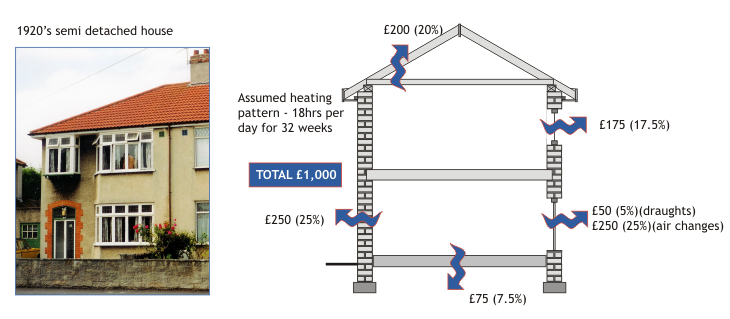Energy Efficiency - Existing Housing
- Home Page
- Principles
- U values & Heat Loss
- Energy Perf Certs.
- Heating
- Ventilation
- Condensation
- Windows
- Roof insulation
- Floor Insulation
- External insulation
- Cavity insulation
- Internal insulation
- Renewables - Intro
- Photovoltaics
- Solar Water Htg
- Wind power
- Ground Source HP
- Air Source HP
- Hydroelectric
- Biomass
- Combined H&P
- Selection
- New Sustainable Homes
There are over 20 million houses in the UK. Most of these are poorly insulated. Many of them also have inefficient heating systems. According to the Energy Saving Trust, domestic energy use is responsible for just over 25 per cent of the UKs carbon dioxide (CO2) emissions. But, by implementing a number of relatively simple improvements, the average household could save two or more tonnes of CO2 every year and, at the same time, substantially reduce its heating bills. There are three main approaches:
- ensure the dwelling is well insulated,
- burn fuel more efficiently - in other words make sure the heating system is efficient,
- invest in renewable technology - to reduce dependence on fossil fuel.
In practice, however, things are not quite so simple. There are a number of competing energy efficiency solutions many of which promise substantial savings, savings which are not always realised following installation. In addition, some 'improvements' can cause unexpected problems such as dampness and condensation. They may also affect the property's appearance.
It's also quite difficult for the average occupier to determine what action is most appropriate for a particular dwelling. For example, is it worth changing an old but reliable boiler, is cavity insulation always a sensible and cost effective option?
One sensible approach is to ask a suitably qualified surveyor to produce an Energy Performance Certificate. An EPC costs about £60 and provides information on a property's energy efficiency. It gives the building a standard energy and carbon emission efficiency grade from A to G, where A is the most efficient and with the average to date being 'D'. It also provides a numerical figure (from 1 to 100) known as a SAP rating (Standard Assessment Procedure). EPCs are measured using the same calculations for all homes, so it's easy to compare the energy efficiency of different properties.
Part of the EPC is a report which lists potential ratings based on a number of recommended changes. The report lists:
- suggested improvements (such as fitting loft insulation)
- the approximate cost
- possible cost savings per year if the improvements are made
- how this would change the energy and carbon emission rating of the property
A good SAP rating can be considered to be anything over 80. The UK average is probably just over 50. The property below, with no insulation at all, has a poor SAP rating - 35 to 39 or so, with CO2 emissions of about 6 tonnes per year. The annual heating cost for a property like this depends on the SAP rating and, of course, the local climate, the length of time the heating is used and the local price of fuel. To show just where most heat losses occur we have used a figure of £1,200, this includes a £200 allowance for water heating.
The drawing below shows the annual cost of heat losses in a modest three bedroom detached house. This particular example has one-brick solid walls, a timber ground floor, an uninsulated roof and single glazing.

Improving the energy efficiency of this property will see fuel bills, and CO2 emissions fall. Lifting the SAP rating from the upper 30s to 80 or so would probably see the annual heating costs fall from £1,000 to about £400 (but will have little impact on water heating costs). CO2 emissions will fall from 6 tonnes to about 2.5 tonnes. But, of course, this could cost several thousand pounds and money can easily be wasted through bad advice and inappropriate solutions.
Effective decisions on energy efficiency can be made without a SAP rating. To do them requires a bit of work on the part of the occupier/owner but, as this web site will show, it's not a particularly daunting or complex task.
Getting the best out of this web site
The main purpose of this web site, therefore, is to offer advice on cost effective energy efficiency options. To this end, it concentrates on six main areas:
- Insulation materials, options and techniques
- Efficient heating systems, heat sources and heat distribution
- Draft exclusion, ventilation and condensation
- Potential risks and defects when installing insulation
- Renewable energy - options and appraisal
- Assessing insulation options and effective system selection
The links on the left will take you to the various sections. If you are primarily interested in Cavity Insulation, for example, you can select this link first. However, to get the best out of this web site we advise you to look through all the sections, even if you don't study them in detail. A broad understanding of all the issues related to energy efficiency, together with knowledge of the technical options and potential pitfalls, will enable you to make appropriate and more effective decisions. The section on U values and Heat Losses is not essential reading although it does explain how U values are calculated and it does provide some typical U values for common forms of construction.
except where acknowledged